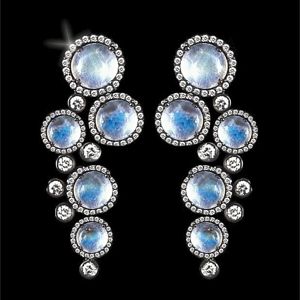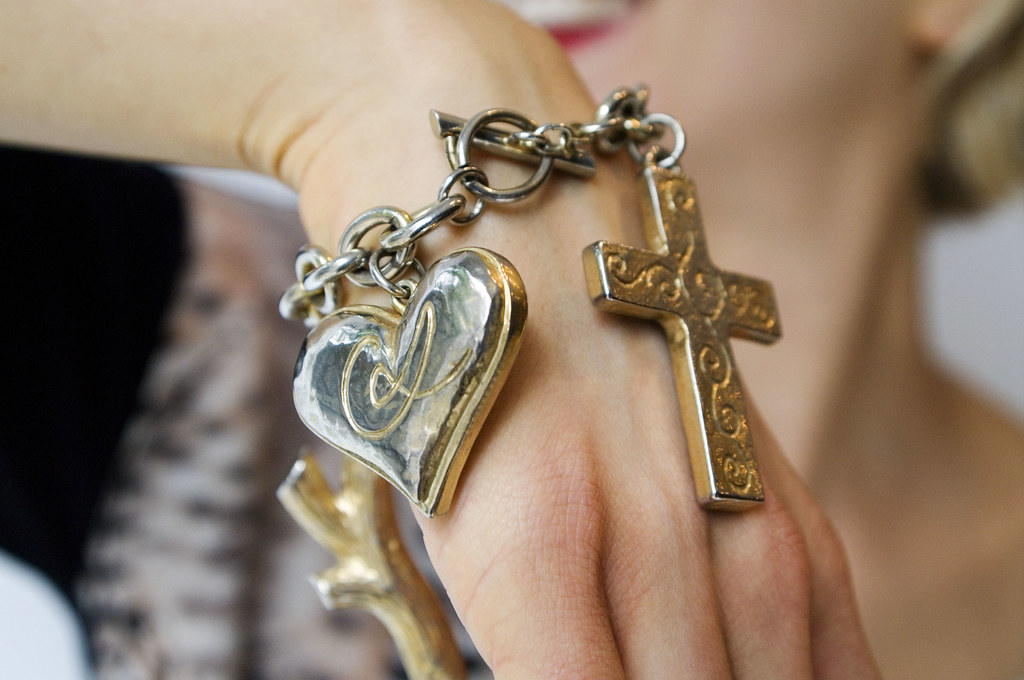French Jewelry Designers Biography
Source (google.com.pk )He met various writers, painters, and musicians befriending, among others,Pierre Gaxotte, Maurice Sachs, Jean Ozenne and his cousin Christian Berard, Max Jacob, and Henri Sauguet.In 1927, after his military service and with his father’s support, he opened an art gallery at 34, rue de la Boetie, with the name of his associate, Jacques Bonjean. The gallery exhibited the works of such contemporary artists as Giorgio de Chirico, Maurice Utrillo, Salvador Dali, Raoul Dufy, Marie Laurencin, Fernand Leger, Jean Lucat, Pablo Picasso, Ossip Zadkine, Georges Braque, and Aristide Maillol.
After the War, Marcel Boussac, president of the cotton-marketing syndicate, offers to finance Dior’s own couture house. At the age of forty-two he presents his first collection “Corolle Line,” which was named by the press “The New Look,” and achieved insurmountable success. The collection was accompanied by the launch of his first perfume, Miss Dior. His “New Look” creations were a composition of rounded shoulders, shapely emphasis of the bust, cinched waists, and curvaceous bell-shaped skirts in luxurious fabrics. In 1947 Dior received the Neiman Marcus Award. The following year, he set up the subsidiary Christian Dior New York, Inc., and branches were set up in Caracas, Australia, Chile, Mexico and Cuba. The “New Look” was Christian Dior’s passport to the American market. During the 50s, the House of Dior was alone responsible for half of all Paris’s couture export to the United States.
Christian Dior’s costume jewelry and other accessories were selected to complement his fashions. Their production was limited. Dior was the first designer to use Aurora Borealis rhinestones. Unlike many other fashion designers at the time, Dior gave painstaking attention to detail in his jewelry, making it clear that these accessories were not a mere afterthought. They were a major, essential aspect of his collections, to be taken as seriously as the lavish clothes he designed. Dior’s affinity with the French countryside was evident in his jewelry collections, which featured many pieces inspired by wild roses and lily of the valley flowers. Figural designs of animals were also a recurring theme.
All of Dior’s jewelry pieces were signed and dated. There are a number of designers who have made collections for Dior over a small period of time. Mitchell Maer held the jewelry license for Dior jewelry from 1950 to 1957; in the United States Kramer of New York held the jewelry license from 1950 to 1957; and also Henkel and Grosse, Josette Gripoix, and Kramer. In particular, Mitchell Maer pieces, designed between 1952 and 1956 are highly sought after. Dior’s costume jewelry was signed Christian Dior inside an oval.
In 1948 the Christian Dior perfume company was set up; it launched Diorama; in 1949, followed by Eau Fraiche (1953), and Diorissimo (1956). His future collections unveiled the finest tailoring and the most sumptuous fabrics: satins, traditional suiting, fine wools, taffetas, and lavish embroideries. His creations were frequently distinguished by ornaments that came directly from pre 1914 fashion.
Christian Dior is considered one of the most famous fashion designers of both the 20th and 21st centuries. In 1957, Dior died of a heart attack at the age of fifty-two in Bagni de Montecatini, Italy. After his death, Marcel Boussac, Dior’s partner appointed Ives Saint Laurent as artistic director, he was followed by Marc Bohan, Gianfranco Ferre, and John Galliano; who has reinvigorated the house of Dior and once again brought renown to the Dior name.
Carl Faberge was born Peter Carl Fabergé in St. Petersburg, Russia on May 30, 1846. His parents were Gustav Fabergé a jeweler and his Danish wife Charlotte Jungstedt. Carl studied at St. Anne’s Gymnasium, the German school in St. Petersburg. In 1860, the family moved to Dresden and sent young Carl Fabergé on a studying trip to Paris, Florence and Frankfurt. He learned the jeweler’s craft at the House of Friedman in Frankfurt am Main.
In 1870 Carl took over the jewelry store due to his father’s illness. Two years later, he married Augusta Julia Jacobs, with whom he had four sons: Eugene, Agathon, Alexander, and Nicholas. All of them eventually joined the family business.
Carl began to design and manufacture jewelry way ahead of what was being produced around him at the time. He was an innovator and embraced new movements with enthusiasm including the “Art Nouveau” movement when it was launched in Europe. Many of the designs made by Fabergé around the 1900s have served as models for several of the leading European Houses even at the present time.
Fabergé encouraged his lapidaries to carve stones for jewels in new and exciting shapes, his enamellers also adopted a wide range of different manners; his metal-workers, the chasers and engravers were also encouraged to employ different colors of gold in beautiful new designs.
Fabergé took pleasure in exploiting the shining dark green beauty of jade, (Siberian nephrite), in many of his favorite designs and was known for selecting the best materials for his jewelry. Besides diamonds, which Fabergé used in both rose-cut and exceptional form, his workshops popularized the use of colored stones both precious and semi-precious. Fabergé was attracted to what was called the “Mecca” stone, which was a translucent pale blue-green chalcedony cut cabochon artificially stained to put out a rose-colored glow. The “Mecca” stone is sometimes confused with moonstone. Some stones mined in Russia such as the Aquamarine, Siberian Emeralds and Amethyst were continuously used by the House of Fabergé.
In 1882, Agathon, Faberge’s younger brother joined the firm. Agathon helped his brother reorganize and expand the business. Agathon was a skilled jeweler in his own right. He was creative, ingenious and driven. It was his influence that redirected the firm away from the heavy, fussy pieces being made until that point and toward the fine, intricate items that would ultimately be recognized as being of Fabergé style. Agathon convinced his brother Carl to participate at the Pan-Russian Exhibition in Moscow in 1882; they were a sensation. The House of Faberge was awarded a gold medal. More importantly however, Carl’s works caught the eye of Alexander III, the Tsar of Russia, who was a great patron of the arts. Faberge's creations were singled out from hundreds of other jewelers by the Tsar. Alexander declared him “the re-inventor of Russian jewelry art," and became his biggest supporter and best customer. Alexander III encouraged Faberge to turn his genius to the production of exquisite items for his family and friends; brooches, cigarette cases, necklaces, miniatures of all kinds and, of also to the creation of the famous Faberge Easter eggs. Faberge also worked with gold, silver, gems, and other materials, and created flower arrangements, figure groups, and animals.
In 1885, the first "Faberge Easter Egg" was presented to the Tsarina Marie Romanova and later that year, Faberge was rewarded with the appointment of jeweler to the Imperial Court, and given the right to have the Imperial Eagle incorporated in the firm's trademark. From 1895 to 1916, Tsar Nicholas II ordered two eggs each year, one for his wife and one for his mother. Eggs were designed to celebrate the coronation of Tsar Nicholas II, the completion of the Trans Siberian Railway, the birth of the Tsarevitch (male heir to the throne), the 15th Anniversary of the Imperial Couple's coronation, and the "Romanov Tercentenary Egg" which commemorated 300 years of Romanov rule. During times of war, eggs were created to honor the Red Cross and the military. In all, 56 eggs were ordered. The Faberge eggs became a beautiful symbol of Russian history and culture.
During the Edwardian Era 1901 to 1910, Fabergé produced a large quantity of jabot brooches which were described as “small brooches” by Fabergé. Another item that was very popular and also produced in large quantities and in a variety of patterns was the belt buckle. It was produced in every possible color and technique in silver and enamel and sometimes in gold or plain. They were often bordered by chased mounts, sometimes set with rose diamonds or pearls.
Haircombs of tortoiseshell usually set with diamonds, a less formal substitute for the tiara were also very popular and produced in large quantities. Faberge’s vast production of products was focused on women’s adornments but he also made a small quantity meant for men’s wear, such as stick-pins, waistcoat buttons, shirt-studs and sleeve-links in a variety of designs and materials.
French Jewelry Designers Jewelry Desgin Sketches Ideas 2014 Neclkace Ring Earringes Gallery Bangles Software Drawing Images Photos Wallpapers

French Jewelry Designers Jewelry Desgin Sketches Ideas 2014 Neclkace Ring Earringes Gallery Bangles Software Drawing Images Photos Wallpapers

French Jewelry Designers Jewelry Desgin Sketches Ideas 2014 Neclkace Ring Earringes Gallery Bangles Software Drawing Images Photos Wallpapers
French Jewelry Designers Jewelry Desgin Sketches Ideas 2014 Neclkace Ring Earringes Gallery Bangles Software Drawing Images Photos Wallpapers

French Jewelry Designers Jewelry Desgin Sketches Ideas 2014 Neclkace Ring Earringes Gallery Bangles Software Drawing Images Photos Wallpapers

French Jewelry Designers Jewelry Desgin Sketches Ideas 2014 Neclkace Ring Earringes Gallery Bangles Software Drawing Images Photos Wallpapers

French Jewelry Designers Jewelry Desgin Sketches Ideas 2014 Neclkace Ring Earringes Gallery Bangles Software Drawing Images Photos Wallpapers
French Jewelry Designers Jewelry Desgin Sketches Ideas 2014 Neclkace Ring Earringes Gallery Bangles Software Drawing Images Photos Wallpapers
.jpg)
French Jewelry Designers Jewelry Desgin Sketches Ideas 2014 Neclkace Ring Earringes Gallery Bangles Software Drawing Images Photos Wallpapers

French Jewelry Designers Jewelry Desgin Sketches Ideas 2014 Neclkace Ring Earringes Gallery Bangles Software Drawing Images Photos Wallpapers

No comments:
Post a Comment